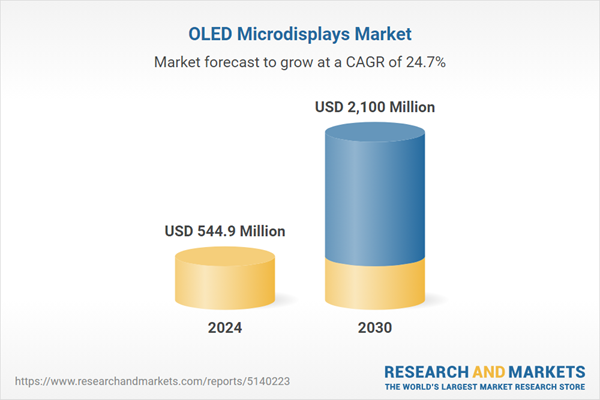The global market for OLED Microdisplays was valued at US$544.9 Million in 2024 and is projected to reach US$2.1 Billion by 2030, growing at a CAGR of 24.7% from 2024 to 2030. This comprehensive report provides an in-depth analysis of market trends, drivers, and forecasts, helping you make informed business decisions. The report includes the most recent global tariff developments and how they impact the OLED Microdisplays market.
Segments: Segment (Near-to-Eye (NTE), Projection, Other Segments); End-Use (Consumer Electronics, Military & Defense, Automotive, Industrial, Medical, Other End-Uses).
Geographic Regions/Countries: World; United States; Canada; Japan; China; Europe (France; Germany; Italy; United Kingdom; and Rest of Europe); Asia-Pacific; Rest of World.
The analysts continuously track trade developments worldwide, drawing insights from leading global economists and over 200 industry and policy institutions, including think tanks, trade organizations, and national economic advisory bodies. This intelligence is integrated into forecasting models to provide timely, data-driven analysis of emerging risks and opportunities.
Global OLED Microdisplays Market - Key Trends & Drivers Summarized
What Are OLED Microdisplays, and Why Are They Important?
OLED microdisplays are small, high-resolution screens used in applications that require compact, lightweight, and power-efficient displays, such as augmented reality (AR) and virtual reality (VR) headsets, camera viewfinders, and wearable devices. These microdisplays leverage OLED technology, where each pixel emits its own light, resulting in deep blacks, high contrast ratios, and vibrant colors. Unlike traditional LCDs, OLED microdisplays do not require a backlight, making them thinner, more efficient, and capable of producing a wider color gamut. With the rise of AR, VR, and other immersive technologies, OLED microdisplays are increasingly favored for their superior visual performance, compact size, and ability to provide a seamless user experience in devices that demand high-resolution, low-latency displays.How is Technology Shaping the OLED Microdisplay Market?
Technological advancements are significantly enhancing the capabilities of OLED microdisplays. Higher pixel densities and faster refresh rates are improving visual clarity and reducing motion blur, making OLED microdisplays ideal for AR and VR applications, where sharp, smooth images are essential for an immersive experience. Additionally, advances in resolution, with microdisplays now offering full-HD and even 4K capabilities, have made them suitable for use in advanced optics and military applications. The integration of OLED microdisplays with head-mounted displays (HMDs) for AR and VR is a key area of development, particularly as industries such as healthcare, defense, and gaming push for more immersive and accurate visualization tools. Flexible and transparent OLED microdisplays are also emerging, allowing for innovative applications in wearable technology and smart glasses, where display transparency and lightweight design are critical. These innovations are not only expanding the use cases for OLED microdisplays but also improving user comfort and device functionality.What Are the Key Applications of OLED Microdisplays?
OLED microdisplays are used across a wide range of applications where high-quality, compact displays are required. In consumer electronics, these microdisplays are found in camera viewfinders and wearable devices, offering crisp images and superior color accuracy. However, the most significant growth area for OLED microdisplays is in AR and VR headsets, which rely on high-resolution, low-latency displays to deliver immersive experiences for gaming, simulations, and training. The defense and aerospace sectors are also key users of OLED microdisplays, particularly for head-mounted displays (HMDs) used by pilots and soldiers to enhance situational awareness. Medical imaging, where precise and high-quality visuals are essential, is another growing application for OLED microdisplays, especially in devices like surgical AR glasses. The combination of compact form factor, high resolution, and energy efficiency makes OLED microdisplays increasingly attractive across these diverse industries.What is Driving the Growth in the OLED Microdisplays Market?
The growth in the OLED microdisplays market is driven by several factors, particularly the increasing demand for AR and VR technologies across industries such as gaming, healthcare, and defense. As AR and VR applications become more mainstream, the need for high-performance, compact displays with superior image quality has surged, positioning OLED microdisplays as a key technology. Technological advancements, such as the development of ultra-high-resolution and low-latency displays, have further accelerated adoption in these sectors. Additionally, the rise of wearable technologies, including smart glasses and fitness devices, has fueled demand for OLED microdisplays that offer lightweight, flexible, and power-efficient solutions. The growing focus on miniaturization and the need for portable, high-quality displays in consumer electronics, such as camera viewfinders, is also contributing to market growth. Lastly, the defense and aerospace industries' increasing reliance on AR systems for training and operational purposes has driven demand for OLED microdisplays that offer exceptional clarity and low power consumption in mission-critical environments.Report Scope
The report analyzes the OLED Microdisplays market, presented in terms of units. The analysis covers the key segments and geographic regions outlined below.Segments: Segment (Near-to-Eye (NTE), Projection, Other Segments); End-Use (Consumer Electronics, Military & Defense, Automotive, Industrial, Medical, Other End-Uses).
Geographic Regions/Countries: World; United States; Canada; Japan; China; Europe (France; Germany; Italy; United Kingdom; and Rest of Europe); Asia-Pacific; Rest of World.
Key Insights:
- Market Growth: Understand the significant growth trajectory of the Near-to-Eye (NTE) segment, which is expected to reach US$758.6 Million by 2030 with a CAGR of a 21.7%. The Projection segment is also set to grow at 28.1% CAGR over the analysis period.
- Regional Analysis: Gain insights into the U.S. market, valued at $159.1 Million in 2024, and China, forecasted to grow at an impressive 24.0% CAGR to reach $315.2 Million by 2030. Discover growth trends in other key regions, including Japan, Canada, Germany, and the Asia-Pacific.
Why You Should Buy This Report:
- Detailed Market Analysis: Access a thorough analysis of the Global OLED Microdisplays Market, covering all major geographic regions and market segments.
- Competitive Insights: Get an overview of the competitive landscape, including the market presence of major players across different geographies.
- Future Trends and Drivers: Understand the key trends and drivers shaping the future of the Global OLED Microdisplays Market.
- Actionable Insights: Benefit from actionable insights that can help you identify new revenue opportunities and make strategic business decisions.
Key Questions Answered:
- How is the Global OLED Microdisplays Market expected to evolve by 2030?
- What are the main drivers and restraints affecting the market?
- Which market segments will grow the most over the forecast period?
- How will market shares for different regions and segments change by 2030?
- Who are the leading players in the market, and what are their prospects?
Report Features:
- Comprehensive Market Data: Independent analysis of annual sales and market forecasts in US$ Million from 2024 to 2030.
- In-Depth Regional Analysis: Detailed insights into key markets, including the U.S., China, Japan, Canada, Europe, Asia-Pacific, Latin America, Middle East, and Africa.
- Company Profiles: Coverage of players such as eMagin Corporation, Kopin Corporation, Microoled, Raystar Optronics, Inc., Sony Semiconductor Solution Corporation and more.
- Complimentary Updates: Receive free report updates for one year to keep you informed of the latest market developments.
Some of the 48 companies featured in this OLED Microdisplays market report include:
- eMagin Corporation
- Kopin Corporation
- Microoled
- Raystar Optronics, Inc.
- Sony Semiconductor Solution Corporation
- WINSTAR Display Co., Ltd.
- Wisechip Semiconductor Inc.
- Yunnan Olightek Opto-Electronic Technology Co., Ltd.
Tariff Impact Analysis: Key Insights for 2025
Global tariff negotiations across 180+ countries are reshaping supply chains, costs, and competitiveness. This report reflects the latest developments as of April 2025 and incorporates forward-looking insights into the market outlook.The analysts continuously track trade developments worldwide, drawing insights from leading global economists and over 200 industry and policy institutions, including think tanks, trade organizations, and national economic advisory bodies. This intelligence is integrated into forecasting models to provide timely, data-driven analysis of emerging risks and opportunities.
What’s Included in This Edition:
- Tariff-adjusted market forecasts by region and segment
- Analysis of cost and supply chain implications by sourcing and trade exposure
- Strategic insights into geographic shifts
Buyers receive a free July 2025 update with:
- Finalized tariff impacts and new trade agreement effects
- Updated projections reflecting global sourcing and cost shifts
- Expanded country-specific coverage across the industry
Table of Contents
I. METHODOLOGYII. EXECUTIVE SUMMARY2. FOCUS ON SELECT PLAYERSIII. MARKET ANALYSISIV. COMPETITION
1. MARKET OVERVIEW
3. MARKET TRENDS & DRIVERS
4. GLOBAL MARKET PERSPECTIVE
UNITED STATES
CANADA
JAPAN
CHINA
EUROPE
FRANCE
GERMANY
ITALY
UNITED KINGDOM
REST OF EUROPE
ASIA-PACIFIC
REST OF WORLD
Companies Mentioned (Partial List)
A selection of companies mentioned in this report includes, but is not limited to:
- eMagin Corporation
- Kopin Corporation
- Microoled
- Raystar Optronics, Inc.
- Sony Semiconductor Solution Corporation
- WINSTAR Display Co., Ltd.
- Wisechip Semiconductor Inc.
- Yunnan Olightek Opto-Electronic Technology Co., Ltd.
Table Information
| Report Attribute | Details |
|---|---|
| No. of Pages | 226 |
| Published | April 2025 |
| Forecast Period | 2024 - 2030 |
| Estimated Market Value ( USD | $ 544.9 Million |
| Forecasted Market Value ( USD | $ 2100 Million |
| Compound Annual Growth Rate | 24.7% |
| Regions Covered | Global |









